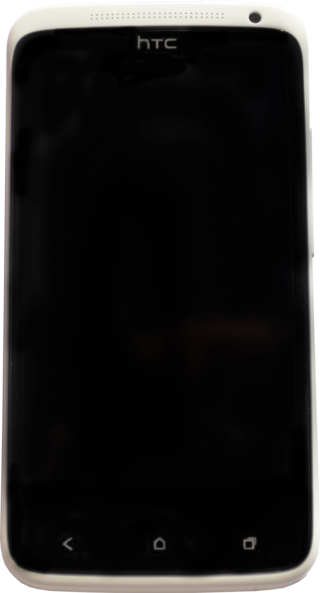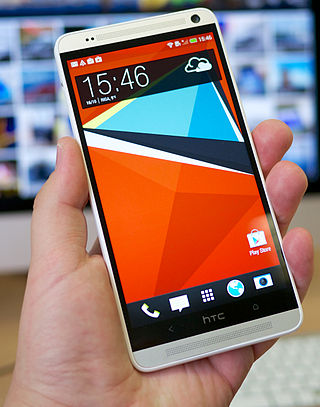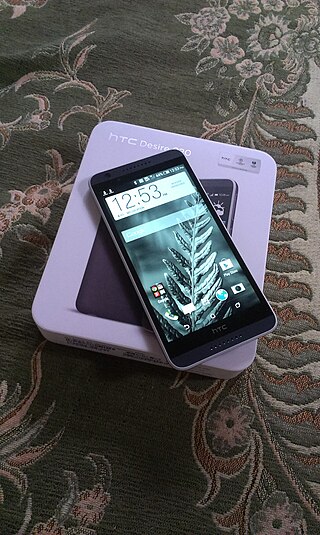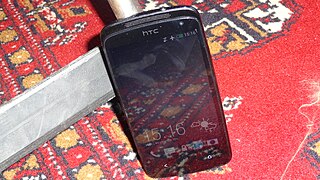Related Research Articles

HTC Sense is a software suite developed by HTC, used primarily on the company's Android-based devices. Serving as a successor to HTC's TouchFLO 3D software for Windows Mobile, Sense modifies many aspects of the Android user experience, incorporating additional features, additional widgets, re-designed applications, and additional HTC-developed applications. The first device with Sense, the HTC Hero, was released in 2009. The HD2 running Windows Mobile 6.5, released later the same year, included Sense. Following the release of the Hero, all future Android devices by HTC were shipped with Sense, except for the Nexus One, the Desire Z, the HTC First, the Google Pixel and Pixel 2, and the Nexus 9 which used a stock version of Android. Also some HTC smartphones that are using MediaTek processors come without HTC Sense.
Google Nexus is a discontinued line of consumer electronic mobile devices that ran a stock version of the Android operating system. Google managed the design, development, marketing, and support of these devices, but some development and all manufacturing were carried out by partnering with original equipment manufacturers (OEMs). Alongside the main smartphone products, the line also included tablet computers and streaming media players; the Nexus started out in January 2010 and reached its end in October 2016, replaced by Google Pixel family.

The HTC One X is a touchscreen-based, slate-sized smartphone designed and manufactured by HTC. It was released running Android 4.0.3, with the HTC Sense 4.0 skin. The One X is powered by the NVIDIA Tegra 3 for most international GSM carriers, making this the first HTC phone to be equipped with a quad-core processor, while a variant which is LTE capable is powered by the Qualcomm Snapdragon S4 dual-core 1.5 GHz Krait processor. The One X was announced on February 26, 2012, at the Mobile World Congress and was HTC's sixth flagship product, leading the HTC One series from the time of its release through April 2013, when its successor the HTC One (M7) was announced.

The HTC One S is a premium smartphone designed and manufactured by HTC as part of the HTC One series which has Beats Audio and runs the Android 4.0 "Ice Cream Sandwich" mobile operating system with HTC Sense. Announced by HTC on 26 February 2012, the HTC One S was scheduled for official release on 2 April 2012. The first phones were sold on March 30. In the United States, the One S is carried by T-Mobile and Solavei.

HTC One is a touchscreen-based Android smartphone designed, developed, and manufactured by HTC. The smartphone was unveiled on 19 February 2013 at press events in New York City and London and is HTC's seventh flagship smartphone. It has been hailed by many as a revolutionary Android handset with its premium design and build quality and its emphasis on high end audio. It is the successor to the company's 2012 flagship model, the One X—which was critically acclaimed, but commercially unsuccessful due in part to insufficient marketing efforts. To make the device stand out among its competition, HTC One was developed with a major emphasis on unique hardware and software features; which included a unibody aluminum frame, a 1080p full-HD display, dual front-facing stereo speakers, a camera with a custom image sensor and the ability to automatically generate montages of media, an updated version of HTC's Sense user experience, BlinkFeed—an aggregator of news and social network content, and an electronic program guide app with the ability to serve as a universal remote via an IR blaster located in the device's power button.

The HTC Butterfly S is an Android smartphone designed and manufactured by HTC. It is exclusive to Asian countries and currently has not been officially released in North America or Europe. The Butterfly S was unveiled on 19 June 2013 for release in Asian markets by July 2013. It is the successor to the HTC Butterfly, and incorporates hardware and software features first introduced by the HTC One, but is distinguished from the One by a larger, 5-inch 1080p display, a larger 3200 mAh battery and a Snapdragon 600 quad-core processor clocked at 1.9 GHz. The Butterfly S has a shiny plastic unibody compared to the aluminum unibody of the One, and has three capacitive buttons instead of two. It lacks the optical image stabilization of the One and the waterproofing of the original Butterfly. It has 16 GB of internal storage and a microSD card slot for storage up to 64 GB. The international 901s variant sold in Asian countries such as Singapore and Hong Kong has support for 4G LTE. The original Taiwanese version (901e) does not have LTE support and is currently available unlocked or on a contract with various carriers (initially only Chunghwa Telecom. An LTE version for Taiwan was announced in January 2014, following the implementation of LTE by various Taiwanese carriers. In China, two variants were released, a regular version with a 3200 mAh battery and a dual SIM version with a 2300 mAh battery. Only the Taiwanese variants officially received Android 5.0.2 Lollipop.

The Samsung Galaxy Star is a low-end smartphone manufactured by Samsung Electronics. It was announced in April 2013, it was subsequently released in May 2013. It is the cheapest smartphone in the Samsung Galaxy series. Like all other Samsung Galaxy smartphones, the Galaxy Star runs on the Android mobile operating system. The phone is available in 2 versions: a single SIM version (GT-S5280) and a dual SIM version (GT-S5282). The phone competes with other low-cost smartphones such as the smartphones from the Nokia Asha series as well as low-cost smartphones manufactured by Indian manufacturers such as Micromax, Karbonn, Spice Digital, Lava International and Celkon. It is available in certain Asian countries such as India, Pakistan, Sri Lanka, Nepal, Bangladesh, Myanmar, Philippines, Indonesia etc. where low-cost smartphones are very popular as well as in Morocco, Algeria, South Africa, Portugal, France, Germany, Russia and Ukraine.

The HTC One Max is an Android phablet smartphone designed and manufactured by HTC. The device is a larger variant of HTC's 2013 flagship high-end smartphone, the HTC One, notably incorporating a 5.9-inch display and fingerprint recognition features.
The HTC Desire 601 is an Android smartphone designed and manufactured by HTC. The Desire 601 is a mid-range device carrying design traits from the HTC One and One Mini, utilizing a dual-core processor, 4.5-inch qHD display, and offering LTE support.

The HTC One (M8) is an Android or Windows smartphone manufactured and marketed by HTC. Following a number of leaks that occurred during the months prior, the device was officially unveiled in a press conference on March 25, 2014, and released the same day by Verizon Wireless at retail, and by other Canadian and United States carriers for online orders prior to its wider retail availability in mid-April.
The HTC Desire 310 is an Android-based smartphone designed and manufactured by HTC. The dual-SIM phone is powered by 1.3 GHz quad-core processor, and has a 4.5-inch screen. The Desire 310 is an entry-level smartphone running Android 4.2 Jelly Bean. The phone features a 1.3 GHz quad-core processor and 1 GB RAM.
Lenovo A526 is a dual-SIM, quad-core MediaTek Cortex A7 based smartphone launched on 2 April 2014. It released on April 5, 2014.
HTC Desire is a series of Android smartphones designed and manufactured by HTC. All products in the Desire series were designed to be affordable, touchscreen-based and slate-sized, and run the Android mobile operating system with the HTC Sense graphical user interface except for the HTC Desire 616, HTC Desire 516. HTC Desire 310 and HTC Desire 210, all of which feature a mixed user interface of HTC Sense and the Android Open Source Project.
The HTC Desire 620 is an Android-based smartphone designed and manufactured by HTC. It is part of the Desire range of mid-range handsets. It was announced on 29 November 2014 in Taiwan. It was announced for the European market on 9 December 2014.

The HTC Desire 820 is a mid range Android-based smartphone designed and manufactured by HTC aired and available from November 2014. It is the successor of HTC Desire 816. The smartphone features a 5.5-inch super LCD 2 display with a 1280x720 resolution. Unlike the scratch resistance glass panel of HTC Desire 816, it has Corning Gorilla Glass lll. Desire 820 supports full hd video recording and play back. It offers HTC Sense 6.5. The processor is a Qualcomm Snapdragon 615, 64 bit ARM Cortex A53 octa-core system on a chip. It is accompanied by 2 GB RAM, 16 GB internal memory, 128 GB external memory capacity and a non removable 2600 mAh battery. It also comes with a 13.0 MP rear-facing camera and 8 MP front-facing camera. The smartphone came with Android KitKat version 4.4.2 and Android Marshmallow was released in 2016.
The HTC Desire 300 is a low-end Android smartphone released by HTC in 2013. The phone was announced on 3 September 2013 in London, England. It was stated that the device would be available in October 2013 in select markets.

The HTC Desire 500 is a low-mid-range Android smartphone released by HTC in 2013. On 23 July 2013, HTC Desire 500 was announced in Taiwan. On 7 August 2013, the device was unveiled for the European market.
The HTC Desire 626 is a mid-range Android smartphone released by HTC in 2015. It comes in single SIM and dual SIM models.
The HTC Desire 616 is a mid-range Android smartphone released by HTC in 2014. It is the first HTC smartphone with an octa-core processor. It was launched on 7 July 2014 in Asian markets. On 11 July 2014, the phone was launched in India for 16900 INR.
References
- ↑ "HTC Desire 600 announced: quad-core processor, dual-SIM and BlinkFeed". Engadget. Archived from the original on 11 June 2013. Retrieved 17 June 2013.
- ↑ "HTC launches dual-SIM Desire 600 with quad-core processor, BlinkFeed". NDTV. 23 May 2013. Archived from the original on 12 June 2013. Retrieved 17 June 2013.